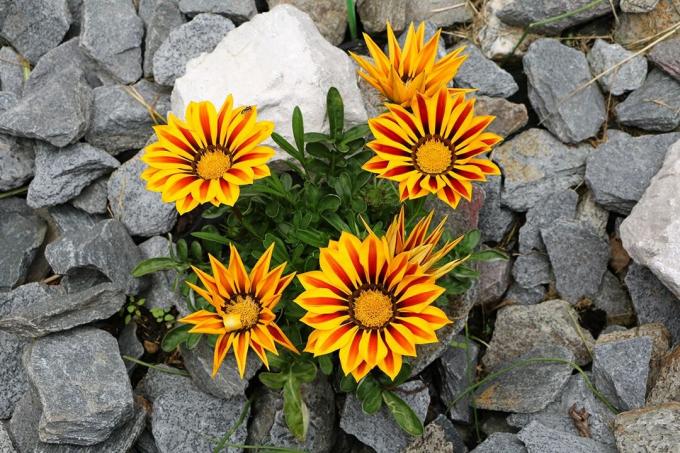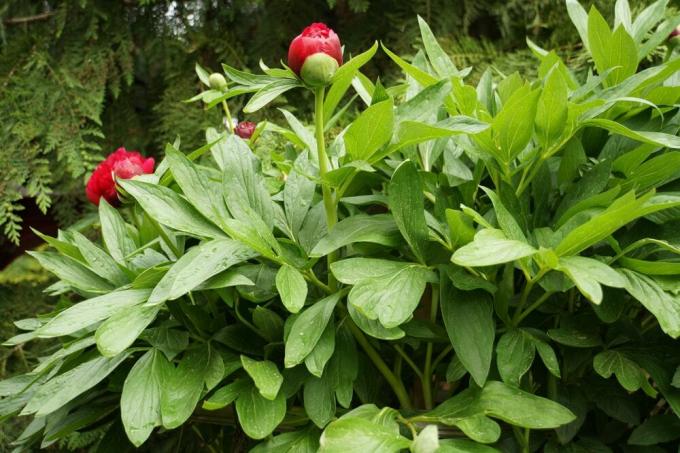

Table of contents
- The first step
- The real cut
- Be careful with supposedly dead shoots
- Trim the roots
- Additional tips for overwintering geraniums
- The spring cut
- Conclusion
- frequently asked Questions
- Geranium care in spring
- This is how a stem is formed
Geraniums belong to the cranesbill family (botanical: Geraniaceae). In contrast to most of its family members, the geranium, which originally comes from southern Africa, is its botanical name, by the way Pelargonium is not hardy, which is why it is essential to bring it indoors for the winter when the days are getting shorter and the nights are getting shorter get colder. But before that, you should cut them back for several reasons.
The first step
Before you start pruning, you should remove the leaves from the geranium. It should be noted that you should not only remove the dried leaves, but also a large part of the lush green leaves. Some gardeners or florists even go so far as to remove all leaves without exception. The reason for this is, on the one hand, that geraniums need less liquid and nutrients over the winter the fewer leaves they have. On the other hand, leafy geraniums are more susceptible to diseases. Dense foliage also encourages pest infestation. Irrespective of this, leafless geraniums hardly take up any space, which is an advantage at the latest if you want to overwinter several plants together in a single bucket.
The real cut
It is generally advised to cut back all geranium shoots by a good two thirds to a maximum total length of 10 to 15 cm. However, it should be remembered that the geraniums should be pruned again in the spring so that they can sprout better as soon as they come outside again. It is therefore advisable to only prune the geraniums by half or a third in autumn. In general, make sure that about two to three knots remain per side shoot. However, no more knots should be left over, otherwise the geranium would get too many fresh shoots in the coming year. You should also use the sharpest pruning shears possible for cutting back, which should be thoroughly cleaned beforehand. Otherwise there is a risk that any pathogens from previous cuts will still stick to the scissors, which could transfer to your geranium.
Tip:
You can grow new plants from the cut shoots by simply placing them on the bright window sill in the First place the Hellen in clear water and repot later as soon as the so-called cuttings have formed their first roots have.
Be careful with supposedly dead shoots
When trimming the geraniums, it is important to completely remove all dead shoots. However, you should exercise particular caution here, as the main wooden shoots often look dead without actually being so. In order to find out which shoots have really died, it is usually sufficient to press them gently between your index finger and thumb. If the shoots feel unusually soft or even downright rotten, this is a clear indication that they are actually dead.
Tip:
If shoots have only partially died, it is usually sufficient to shorten them about 1 or 2 cm deep in the healthy wood towards the trunk.
Trim the roots
Before bringing your geraniums indoors for the winter, it's best to repot them to ensure their soil is free of bugs and potential pathogens. Apart from that, it can be advisable to prune the roots a little in addition to the shoots, for which you would have to remove the soil completely anyway. When pruning or thinning out the roots, the fibrous, thin “roots” are primarily removed by either plucking them off by hand or cutting them off with pruning shears. However, you should make sure that a sufficiently large proportion of the so-called fine roots remain, as your geraniums absolutely need them to survive. Finally, you can still prune back the actual stem or main roots a bit if needed, although too a certain restraint is required here, otherwise there is a risk that your geraniums will no longer be correct grow.
Tip:
Always repot geraniums after cutting back the shoots, as they are much easier to handle then.
Additional tips for overwintering geraniums
Probably the most important criterion when overwintering geraniums is the location, which should be as bright as possible. In addition, the ambient temperature should be at least 5 to a maximum of 10 °C. In this context, it must be noted that in moderately lit winter quarters should tend towards cooler temperatures, otherwise the geraniums will sprout prematurely could. It is also important that the geranium soil is kept slightly moist throughout.
The spring cut
As previously noted, you should prune your geraniums again in spring. How many centimeters you should prune your geraniums depends of course on how far you have already cut them back in autumn. As a result, no binding information can be given to you at this point. In principle, however, all dried-up areas on the cut edges of the previous pruning should be cut off in autumn without exception. Consequently, when pruning in the fall, you should be careful to leave a minimum distance of a good centimeter or more between the thickened plant buds and the cutting point. Apart from that, it may be advisable to cover the geraniums again with fresh soil after spring pruning to ensure they are optimally supplied with nutrients during their budding phase become. It should be noted that plants reduce their nutrient uptake so much during the winter that the fresh soil from the previous one Repotting in the fall should still be nutritious enough to meet the rapidly increasing nutrient needs of your geraniums in the spring cover.
Conclusion
First, the geraniums are (almost) completely freed from their foliage. Then all the shoots are cut to the desired size with the sharpest possible and previously cleaned pruning shears Trimmed in length, it is essential to maintain a minimum distance between the buds and the cutting point. Then the geraniums can be placed in fresh garden soil, whereby the roots should be thinned out a little and shortened if necessary.
frequently asked Questions
No, since the nutrient requirements of your geraniums are generally very low throughout the winter and only increase again next spring with the next growth phase, you do not need to fertilize extra. In fact, it is even advisable not to fertilize at all throughout the winter.
What can be the reason that my geraniums got weak shoots with pale green leaves after the pruning in autumn? – In all likelihood, the location was/is too dark and warm, causing your geraniums to start sprouting again too early.
No, the interfaces usually do not need to be treated as they usually dry out quickly, which provides a kind of natural protection.
Geranium care in spring
- Spring cleaning keeps geraniums healthy and thriving. Remove wilted and damaged leaves.
- Shorten the green, firm shoots to three to four leaf bases so that they branch profusely and remove damaged shoots.
- Well-rooted plants get a new pot in spring, leaving 2 to 3 cm of space for new soil around the root.
- Use fresh balcony potting soil mixed with some gravel or sand. Leave a pouring edge 2 cm high.
- Once a week you should provide geraniums with liquid fertilizer, which is mixed with the irrigation water.
- Alternatively, at the beginning of the season, slow-release fertilizer or fertilizer sticks are added to the soil, which will last for several months.
This is how a stem is formed
Well-formed tall stems of geraniums are a feast for the eyes. However, they are not exactly cheap if you buy them from the gardener. But there are alternatives. You can grow high stems yourself:
- Select a healthy, vigorous pelargonium and cut off all but one main shoot at the base.
- To ensure that the tree grows straight, the shoot is tied to a support rod. Cut off the lower leaves.
- Remove all regrowing side shoots except for the crown area.
- Once the desired height has been reached, all main and side shoots are pinched out until a compact crown has formed.
 garden editorial
garden editorial I write about everything that interests me in my garden.
Learn more about flowers

Midday gold, Gazania: proper care and wintering
The midday gold, which impresses with its colorful and sun-loving flowers, is one of the most popular perennials for local gardeners. The right tips for caring for and overwintering the Gazania have been put together for you here.

Caring for, overwintering and cutting asters | Instructions
The radiant flowers of the asters enchant every garden as well as in pots, terraces and balconies, depending on the variety, from May until well into autumn. Caring for the perennials is not that difficult if everything is known about wintering and cutting.

Magnificent pier, Astilbe: care instructions from A - Z
Astilbe is very popular in the garden. Still, gardeners need to consider a few things if they want the plants to thrive. In our A-Z care instructions, you will learn everything you need to know about the splendor, from flowering to winter protection.

California Poppy, Eschscholzia californica: Care Instructions
Hardly any garden plant is as easy to care for as Californian poppy (Eschscholzia californica), which, with its golden yellow flowers, is a feast for the eyes in the home garden. In order to ensure the bright sea of flowers, a few points should be considered with regard to care.

17 hardy bee-friendly flowers
There has been talk of bee deaths for years. You absolutely need help to survive. Bees are an important part of our ecosystem. Garden owners can also help the small insects with the design of their green oasis.

When do peonies bloom? | Beginning and duration of the flowering period
Peonies are garden perennials that, after a few years, form a veritable sea of flowers in early summer. The individual flowers are long-lasting and are also suitable for cutting. Depending on the variety, they bloom in different colors. But when exactly is the heyday?



